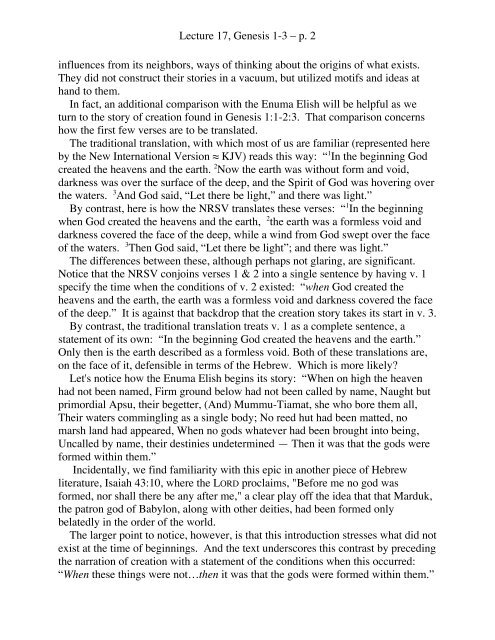Lecture 17: The Primeval Narrative (Genesis 1-3) History-telling in ...
Lecture 17: The Primeval Narrative (Genesis 1-3) History-telling in ...
Lecture 17: The Primeval Narrative (Genesis 1-3) History-telling in ...
You also want an ePaper? Increase the reach of your titles
YUMPU automatically turns print PDFs into web optimized ePapers that Google loves.
<strong>Lecture</strong> <strong>17</strong>, <strong>Genesis</strong> 1-3 – p. 2<br />
<strong>in</strong>fluences from its neighbors, ways of th<strong>in</strong>k<strong>in</strong>g about the orig<strong>in</strong>s of what exists.<br />
<strong>The</strong>y did not construct their stories <strong>in</strong> a vacuum, but utilized motifs and ideas at<br />
hand to them.<br />
In fact, an additional comparison with the Enuma Elish will be helpful as we<br />
turn to the story of creation found <strong>in</strong> <strong>Genesis</strong> 1:1-2:3. That comparison concerns<br />
how the first few verses are to be translated.<br />
<strong>The</strong> traditional translation, with which most of us are familiar (represented here<br />
by the New International Version ≈ KJV) reads this way: “ 1 In the beg<strong>in</strong>n<strong>in</strong>g God<br />
created the heavens and the earth. 2 Now the earth was without form and void,<br />
darkness was over the surface of the deep, and the Spirit of God was hover<strong>in</strong>g over<br />
the waters. 3 And God said, “Let there be light,” and there was light.”<br />
By contrast, here is how the NRSV translates these verses: “ 1 In the beg<strong>in</strong>n<strong>in</strong>g<br />
when God created the heavens and the earth, 2 the earth was a formless void and<br />
darkness covered the face of the deep, while a w<strong>in</strong>d from God swept over the face<br />
of the waters. 3 <strong>The</strong>n God said, “Let there be light”; and there was light.”<br />
<strong>The</strong> differences between these, although perhaps not glar<strong>in</strong>g, are significant.<br />
Notice that the NRSV conjo<strong>in</strong>s verses 1 & 2 <strong>in</strong>to a s<strong>in</strong>gle sentence by hav<strong>in</strong>g v. 1<br />
specify the time when the conditions of v. 2 existed: “when God created the<br />
heavens and the earth, the earth was a formless void and darkness covered the face<br />
of the deep.” It is aga<strong>in</strong>st that backdrop that the creation story takes its start <strong>in</strong> v. 3.<br />
By contrast, the traditional translation treats v. 1 as a complete sentence, a<br />
statement of its own: “In the beg<strong>in</strong>n<strong>in</strong>g God created the heavens and the earth.”<br />
Only then is the earth described as a formless void. Both of these translations are,<br />
on the face of it, defensible <strong>in</strong> terms of the Hebrew. Which is more likely?<br />
Let's notice how the Enuma Elish beg<strong>in</strong>s its story: “When on high the heaven<br />
had not been named, Firm ground below had not been called by name, Naught but<br />
primordial Apsu, their begetter, (And) Mummu-Tiamat, she who bore them all,<br />
<strong>The</strong>ir waters comm<strong>in</strong>gl<strong>in</strong>g as a s<strong>in</strong>gle body; No reed hut had been matted, no<br />
marsh land had appeared, When no gods whatever had been brought <strong>in</strong>to be<strong>in</strong>g,<br />
Uncalled by name, their dest<strong>in</strong>ies undeterm<strong>in</strong>ed — <strong>The</strong>n it was that the gods were<br />
formed with<strong>in</strong> them.”<br />
Incidentally, we f<strong>in</strong>d familiarity with this epic <strong>in</strong> another piece of Hebrew<br />
literature, Isaiah 43:10, where the LORD proclaims, "Before me no god was<br />
formed, nor shall there be any after me," a clear play off the idea that that Marduk,<br />
the patron god of Babylon, along with other deities, had been formed only<br />
belatedly <strong>in</strong> the order of the world.<br />
<strong>The</strong> larger po<strong>in</strong>t to notice, however, is that this <strong>in</strong>troduction stresses what did not<br />
exist at the time of beg<strong>in</strong>n<strong>in</strong>gs. And the text underscores this contrast by preced<strong>in</strong>g<br />
the narration of creation with a statement of the conditions when this occurred:<br />
“When these th<strong>in</strong>gs were not…then it was that the gods were formed with<strong>in</strong> them.”



